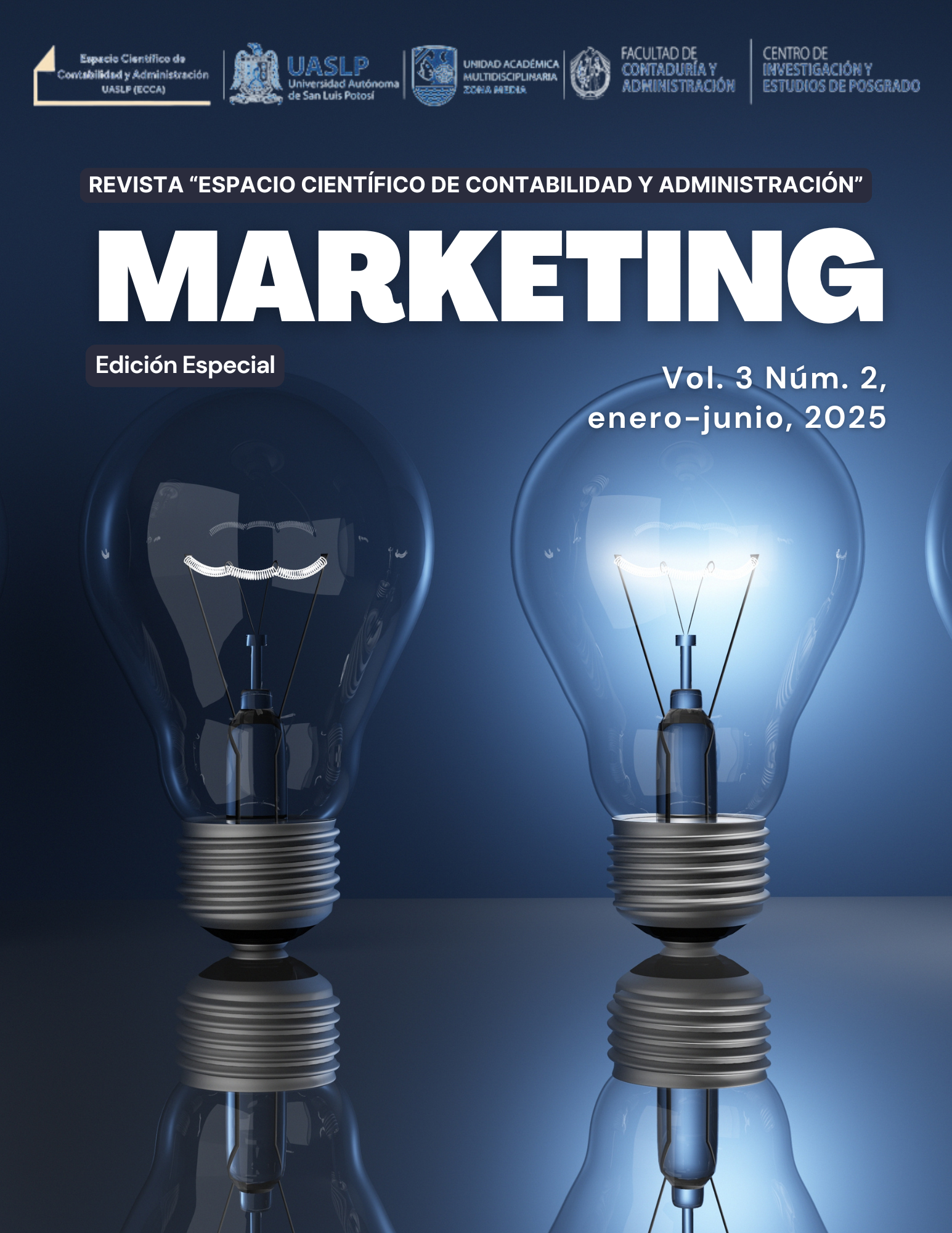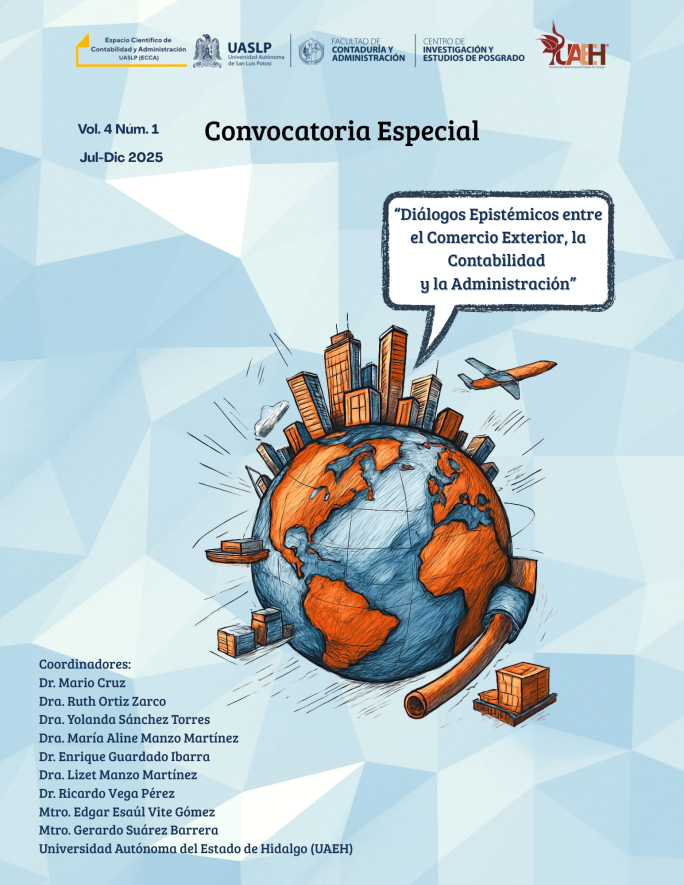The Exploring Service Quality in the Faculty of Marketing
DOI:
https://doi.org/10.58493/ecca.2025.3.2.02Keywords:
quality, service, students, attentionAbstract
Service quality in educational institutions is a key factor for student satisfaction and academic success. In this context, the School of Marketing at the Autonomous University of Coahuila seeks to strengthen its educational offerings through the analysis of student perceptions of the services provided. The objective of this research was to evaluate the relationship between student service, facility conditions, and academic quality with service perceptions, considering gender and place of birth as control variables. A quantitative approach with a cross-sectional, descriptive, and exploratory design was used, administering questionnaires to 214 students between January and March 2019. Through analysis using SmartPLS, the reliability and validity of the constructs were verified. The results revealed that student service and facility conditions have a positive impact on service perceptions, while academic quality and gender did not show significant effects. However, birthplace influenced perceptions of service delivery, suggesting the need to adapt institutional strategies to address student diversity. These findings offer valuable information for improving university services and pave the way for future research that delves deeper into the impact of sociocultural factors on perceptions of educational quality.
References
Abdullah, F. (2006). Measuring service quality in higher education: Three instruments compared. International Journal of Research & Method in Education, 29(1), 71-89.
Alam, M., Malik, Z., Hassan, M., & Zahid Iqbal, M. (2012). Measuring students' perceptions and expectations in Pakistani business schools. Asian Journal of Business and Management Sciences, 1(6), 34-45.
Arambewela, R., & Hall, J. (2009). An empirical model of international student satisfaction. Asia Pacific Journal of Marketing and Logistics, 21(4), 555-569.
Bitner, M. J. (1992). Servicescapes: The impact of physical surroundings on customers and employees. Journal of Marketing, 56(2), 57-71. https://doi.org/10.1177/002224299205600205
Ccoto Tacusi, T. F. (2023). Desempeño docente en la calidad educativa. Horizontes Revista de Investigación en Ciencias de la Educación, 7(29), 1361-1373. https://doi.org/10.33996/revistahorizontes.v7i29.597
Diamantopoulos, A., & Siguaw, J. A. (2006). Formative versus reflective indicators in organizational measure development: A comparison and empirical illustration. British Journal of Management, 17(4), 263-282.
Douglas, J., & Douglas, A. (2006). Evaluating teaching quality. Quality in Higher Education, 12(1), 3-13.
García Domínguez, A. A., Gamarra Rivera, M. D., & Cruzado Portalanza, Á. I. (2022). Calidad de servicio en educación superior. Horizontes. Revista de Investigación en Ciencias de la Educación, 6(23), 744–758. https://doi.org/10.33996/revistahorizontes.v6i23.374
Goldstein, S. M., Johnston, R., Duffy, J., & Rao, J. (2002). The service concept: The missing link in service design research? Journal of Operations Management, 20(2), 121-134.
Gounaris, S., Tzempelikos, N., & Chatzipanagiotou, K. (2003). Cultural distance, satisfaction and service quality perception: The case of international students in the UK. Journal of International Business Studies, 34(5), 1-20.
Grönroos, C. (2020). Service management and marketing: Managing the service profit logic. John Wiley & Sons.
Hair, J. F., Hult, G. T. M., Ringle, C. M., & Sarstedt, M. (2014). A primer on partial least squares structural equation modeling (PLS-SEM). Sage Publications.
Hair, J. F., Sarstedt, M., Ringle, C. M., & Gudergan, S. P. (2017). Advanced issues in partial least squares structural equation modeling. Sage Publications.
Henseler, J., Ringle, C. M., & Sarstedt, M. (2015). A new criterion for assessing discriminant validity in variance-based structural equation modeling. Journal of the Academy of Marketing Science, 43(1), 115-135.
Iacobucci, D., Posavac, S. S., Kardes, F. R., Schneider, M. J., & Popovich, D. L. (2020). The median split: Robust, refined, and revived. Journal of Consumer Psychology, 30(3), 593-604.
Lago, D., Gamoba, A., & Montes, A. (2014). Representations of students about higher education and its quality: An approach from the students' perspective. Educación y Cultura, 21(1), 19-34.
Matzler, K., & Ratzinger, S. (2021). The role of facilities in student satisfaction: An empirical study. Journal of Service Research, 24(3), 271-284.
Martínez-Chairez, E., Guevara-Araiza, A., & Valles-Ornelas, M. M. (2016). El desempeño del docente como factor asociado a la calidad educativa. Revista de Educación y Desarrollo, 40, 1-6. Recuperado de https://www.redalyc.org/journal/440/44055139021/
Miao, Q., & Wei, Q. (2022). Student support and service quality in higher education: The mediating role of student engagement. Higher Education Quarterly, 76(1), 21-34.
Morgeson, F. V., Ramaswamy, K., & Hanks, M. (2020). Service quality and customer satisfaction in the service sector: A systematic review. Journal of Service Research, 23(2), 150-164. https://doi.org/10.1177/1094670520902990
Nunnally, J. C. (1978). Psychometric theory (2nd ed.). McGraw-Hill.
Orden Jurídico (2019). Constitución Política de los Estados Unidos Mexicanos. Artículo 3ro.
Ortega Mohedano, F. (2015). Gestión de calidad en las instituciones de educación superior: una perspectiva global. Universidad Complutense de Madrid.
Parasuraman, A., Zeithaml, V. A., & Berry, L. L. (1985). A conceptual model of service quality and its implications for future research. Journal of Marketing, 49(4), 41-50. https://doi.org/10.1177/002224298504900403
Raffino, N. (2019). Definición de servicios. Economipedia.
Sánchez, Pacheco, & Gándara. (2006). Calidad educativa y la evaluación de programas de posgrado: Una experiencia desde la perspectiva del usuario. Revista de Educación Superior, 35(1), 123-144.
Secretaría de Educación Pública (2007). Programa Sectorial de Educación 2006-2012.
Torres, F., & Araya, R. (2010). The relationship between service quality and student satisfaction in higher education institutions. Journal of Higher Education Policy and Management, 32(3), 273-282.
Vásquez Carrasco, J. (2015). La calidad de los servicios educativos percibida por los estudiantes en universidades de gestión privada en Chile. Revista de Calidad en la Educación Superior, 26(3), 45-60.
Veliz Briones, V. F., Alonso Becerra, A., Alfonso, D., Fleitas Triana, M. S., & Michelena, E. (2020). Procedimiento de gestión para asegurar la calidad de una universidad. Caso de estudio: Universidad Técnica de Manabí. Ingeniare. Revista Chilena de Ingeniería, 28(1), 143-154. https://doi.org/10.4067/S0718-33052020000100143

Downloads
Published
Issue
Section
License
Copyright (c) 2025 Ana Lucia Ruiz Vigil, Adriana Mendez Wong, Juan Bernardo Amezcua Núñez

This work is licensed under a Creative Commons Attribution-NonCommercial-ShareAlike 4.0 International License.
Usted es libre de:
- Compartir — copiar y redistribuir el material en cualquier medio o formato
- Adaptar — remezclar, transformar y construir a partir del material
- La licenciante no puede revocar estas libertades en tanto usted siga los términos de la licencia
Bajo los siguientes términos:
- Atribución — Usted debe dar crédito de manera adecuada , brindar un enlace a la licencia, e indicar si se han realizado cambios . Puede hacerlo en cualquier forma razonable, pero no de forma tal que sugiera que usted o su uso tienen el apoyo de la licenciante.
- NoComercial — Usted no puede hacer uso del material con propósitos comerciales .
- CompartirIgual — Si remezcla, transforma o crea a partir del material, debe distribuir su contribución bajo la la misma licencia del original.
- No hay restricciones adicionales — No puede aplicar términos legales ni medidas tecnológicas que restrinjan legalmente a otras a hacer cualquier uso permitido por la licencia.












